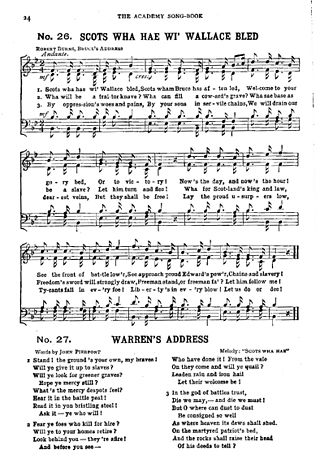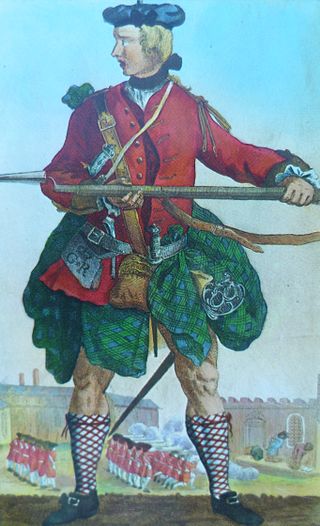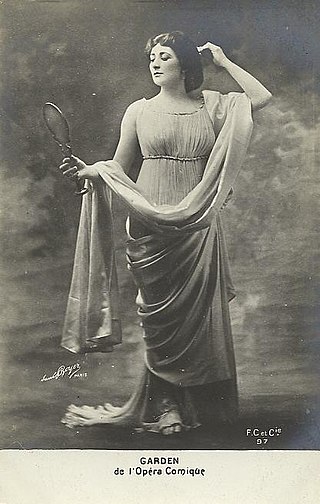Lallans, is a term that was traditionally used to refer to the Scots language as a whole. However, more recent interpretations assume it refers to the dialects of south and central Scotland, while Doric, a term once used to refer to Scots dialects in general, is now generally seen to refer to the Mid Northern Scots dialects spoken in the north-east of Scotland.

Ulster Scots or Ulster-Scots, also known as Ulster Scotch and Ullans, is the dialect spoken in parts of Ulster, being almost exclusively spoken in parts of Northern Ireland and County Donegal. It is normally considered a dialect or group of dialects of Scots, although groups such as the Ulster-Scots Language Society and Ulster-Scots Academy consider it a language in its own right, and the Ulster-Scots Agency and former Department of Culture, Arts and Leisure have used the term Ulster-Scots language.

"Scotland the Brave" is a Scottish patriotic song, one of three often considered an unofficial Scottish national anthem.

Nemo me impune lacessit is the national motto of Scotland. It also served as the national motto of the historic Kingdom of Scotland prior to the Treaty of Union 1707.

"Auld Lang Syne" is a Scottish song. In the English-speaking world, it is traditionally sung to bid farewell to the old year at the stroke of midnight on New Year's Eve/Hogmanay. By extension, it is also often heard at funerals, graduations, and as a farewell or ending to other occasions; for instance, many branches of the Scouting movement use it to close jamborees and other functions.
Flowers of the Forest, or The Fluuers o the Forest, is a Scottish folk tune and work of war poetry commemorating the defeat of the Scottish army, and the death of James IV, at the Battle of Flodden in September 1513. Although the original words are unknown, the melody was recorded c. 1615–1625 in the John Skene of Halyards Manuscript as "Flowres of the Forrest", although it might have been composed earlier.

The Scots Musical Museum was an influential collection of traditional folk music of Scotland published from 1787 to 1803. While it was not the first collection of Scottish folk songs and music, the six volumes with 100 songs in each collected many pieces, introduced new songs, and brought many of them into the classical music repertoire.

"Scots Wha Hae" is a patriotic song of Scotland written using both words of the Scots language and English, which served for centuries as an unofficial national anthem of the country, but has lately been largely supplanted by "Scotland the Brave" and "Flower of Scotland".

Wesley College, Colombo, popularly known as "Wesley" or "The Double Blues" is a Methodist school providing primary and secondary education in Sri Lanka since 1874.

The Scottish Fantasy in E-flat major, Op. 46, is a composition for violin and orchestra by Max Bruch. Completed in 1880, it was dedicated to the virtuoso violinist Pablo de Sarasate.
Puirt à beul is a traditional form of song native to Scotland that sets Gaelic lyrics to instrumental tune melodies. Historically, they were used to accompany dancing in the absence of instruments and to transmit instrumental tunes orally.
"The Parting Glass" is a Scottish traditional song, often sung at the end of a gathering of friends. It has also long been sung in Ireland, where it remains popular and has strongly influenced how it is often sung today. It was purportedly the most popular parting song sung in Scotland before Robert Burns wrote "Auld Lang Syne".
"Hey, Johnnie Cope, are Ye Wauking Yet?", also "Hey Johnnie Cope, are you awake yet?", "Heigh! Johnnie Cowp, are ye wauken yet?", or simply "Johnny Cope" is a Scottish folk song that also features in bagpipe recitals.

There is currently no agreed national anthem of Scotland. In sporting events and significant national situations, songs are used as de facto Scottish national anthems, most notably "Flower of Scotland" and "Scotland the Brave". The Scottish Government has not formally adopted an official national anthem of Scotland, and said in 2015 that it had "no current plans in this regard" to formally adopt a national anthem of Scotland.

"Charlie Is My Darling" is the title of a number of traditional Scots songs.
"The Keel Row" is a traditional Tyneside folk song evoking the life and work of the keelmen of Newcastle upon Tyne. A closely related song was first published in a Scottish collection of the 1770s, but may be considerably older, and it is unclear whether the tune is Scottish or English in origin.
King Robert I of Scotland, also known as Robert the Bruce has been depicted in literature and popular culture many times. This list includes some examples.

The Garb of Old Gaul is an 18th-century patriotic Scottish march and song about Highland soldiers during the Seven Years' War.

Classical music in Scotland is all art music in the Western European classical tradition, between its introduction in the eighteenth century until the present day. The development of a distinct tradition of art music in Scotland was limited by the impact of the Scottish Reformation on ecclesiastical music from the sixteenth century. Concerts, largely composed of "Scottish airs", developed in the seventeenth century and classical instruments were introduced to the country. Music in Edinburgh prospered through the patronage of figures including Sir John Clerk of Penicuik. The Italian style of classical music was probably first brought to Scotland by the cellist and composer Lorenzo Bocchi, who travelled to Scotland in the 1720s. The Musical Society of Edinburgh was incorporated in 1728. Several Italian musicians were active in the capital in this period and there are several known Scottish composers in the classical style, including Thomas Erskine, 6th Earl of Kellie, the first Scot known to have produced a symphony.

Music of Scotland in the nineteenth century includes all forms of music production in the period, in Scotland or by Scottish people.











